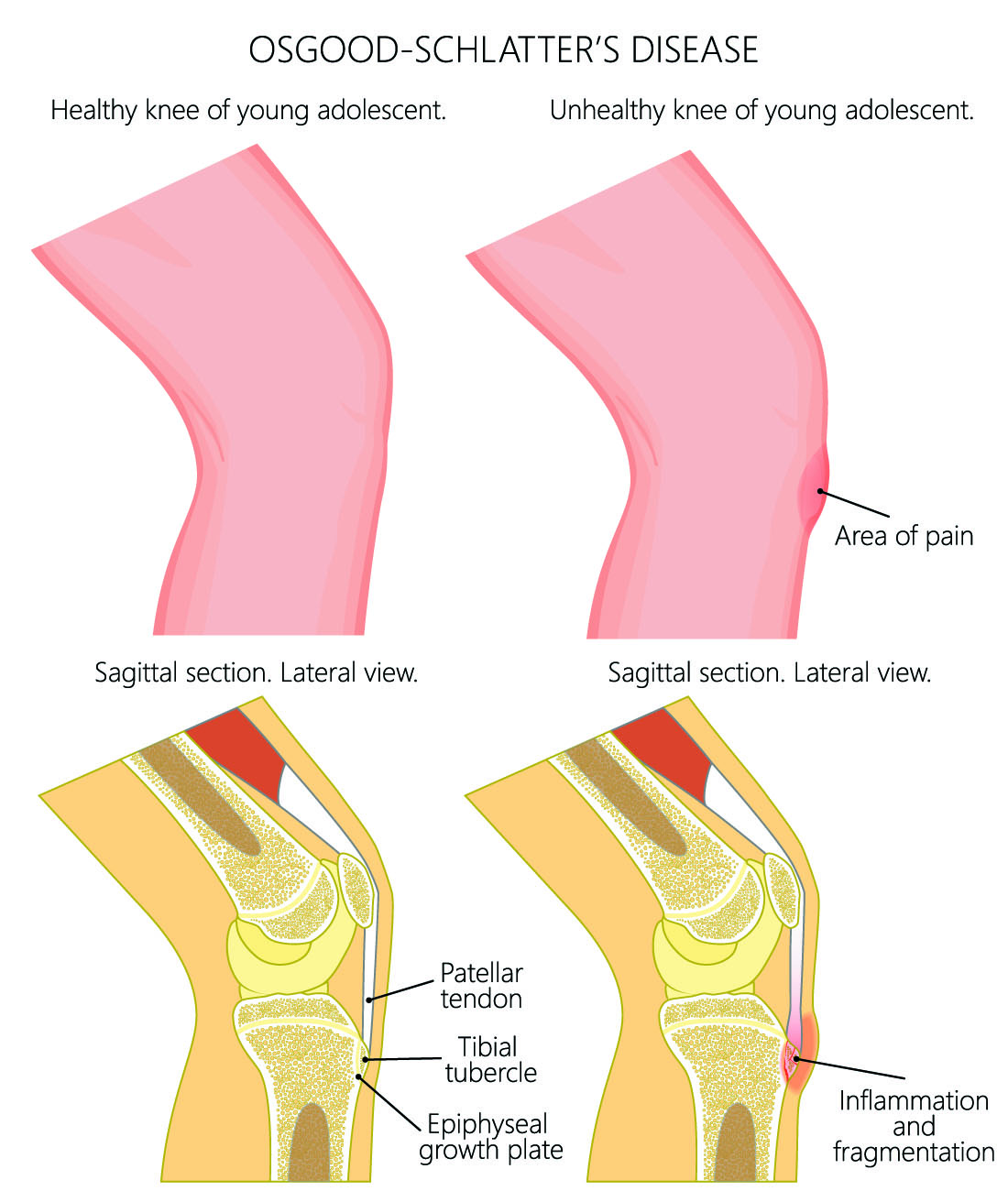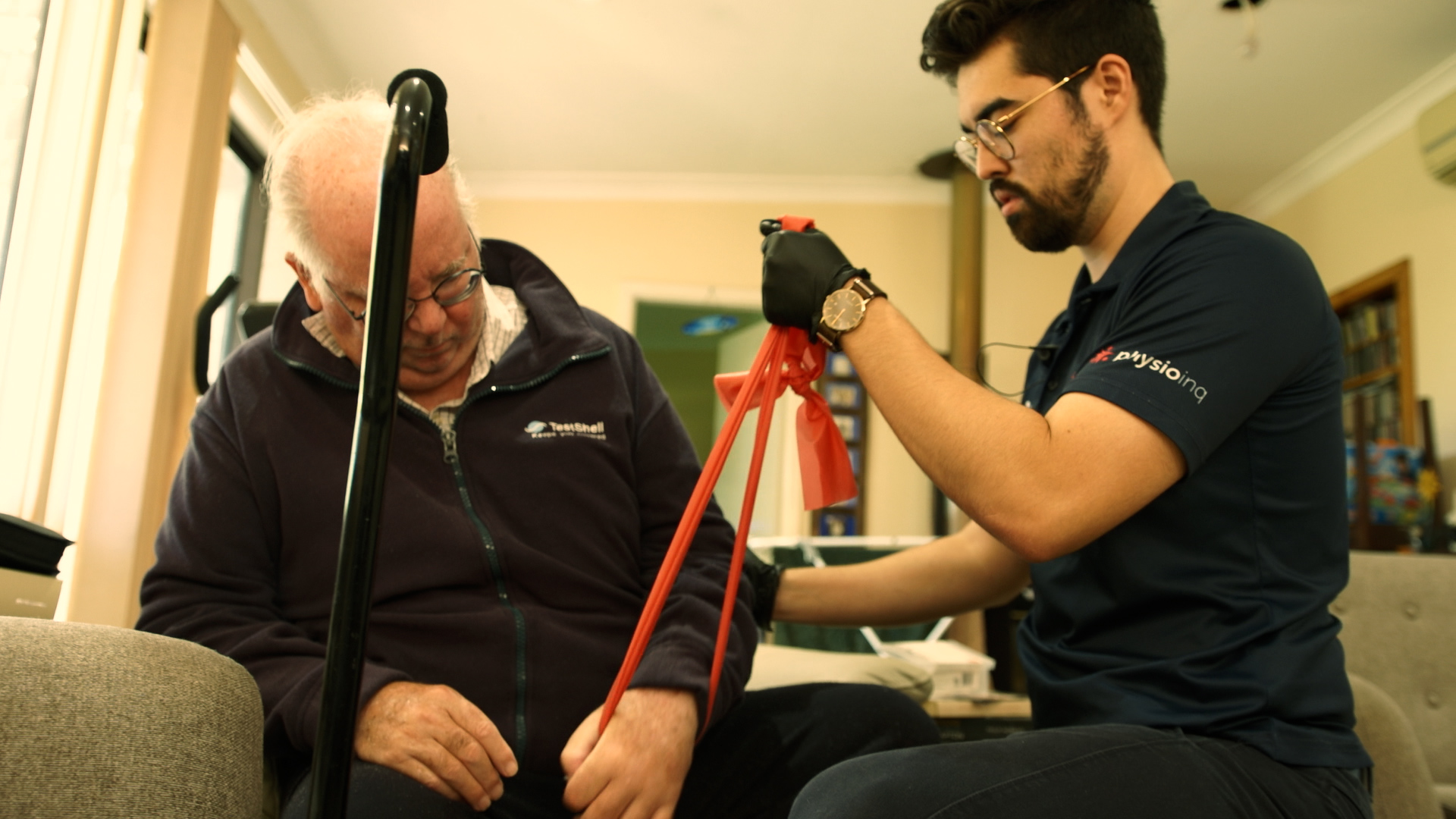Make an Appointment
Osgood-Schlatter disease is a painful condition causing inflammation just below the knee. Common in adolescents during growth spurts, Osgood-Schlatter disease can affect adults if not properly assessed and treated.
What is Osgood-Schlatter disease?
Aptly named after Robert Osgood (a U.S. orthopedic surgeon) and Carl Schlatter (a Swiss surgeon), Osgood-Schlatter disease is characterized as inflammation in the area just below the knee where the kneecap (patellar) tendon meets the shinbone (tibia). This area consists of a growth plate called the ‘tibial tubercle’. Similar to Sever’s disease, Osgood-Schlatter disease is caused by repetitive movements such a running, jumping and sprinting. Pain associated with sudden spurts of growth in children and teenagers is often chalked up to ‘growing pains’, but if not assessed and treated, Osgood-Schlatter disease can follow adolescents into adulthood.

Osgood-Schlatter disease symptoms
As children make their way through adolescence and into adulthood, their bodies grow, sometimes rapidly. Muscles and tendons will not always grow at the same speed which can put added stress onto growth plates. The tibial tubercle, often becomes inflamed by overdevelopment of the quadricep muscles especially when combined with physical activity. The weakening of the tibial tubercle due to overstress and overuse leads to Osgood-Schlatter disease developing. Some of the symptoms of Osgood-Schlatter disease are:
- Pain, swelling or tenderness in the knee or lower leg
- Increased warmth around the area of the tibial tubercle
- Pain when running, walking, kneeling or going up/down stairs
- Impaired movement of the knee
- Lumping (usually tender to the touch) around the tibial tubercle
**Depending on the severity, symptoms may go away over time but if pain or discomfort persists for longer than a few weeks it is always best to see a professional.
Assessing Osgood-Schlatter disease
A physiotherapist will be able to assess symptoms of Osgood-Schlatter disease and implement treatment. There are several tests that a trained professional can use to confirm diagnosis of Osgood-Schlatter disease. For serious cases, X-ray, MRI and bone scans can be used to assess Osgood-Schlatter disease as well as many simple, physical exams that will differentiate between that of a serious condition and normal growing pains.
Unlike physicians, you don’t need a referral to see a physiotherapist and can simply make an online booking to receive assessment and treatment for pain and discomfort. Simple techniques, such as taping, can help speed up recovery and relieve symptoms of Osgood-Schlatter disease before it worsens along with other non-invasive treatments.
Treatment of Osgood-Schlatter disease
The purpose of treating Osgood-Schlatter symptoms is to reduce/eliminate pain and restore natural foot and leg movement. Some of the most common and effective forms of treatment are:
1. Rest, ice, compression and elevation:
Similar to treating sprains and strains, pain and swelling can be significantly reduced through a treatment method known as ‘R.I.C.E’. The combination of resting the injured area, applying ice (15-20 minutes on/off), compression (with a bandage or tape) and elevating it (above the heart), aids tremendously in healing and re-establishing flexibility.
2. Taping:
You can learn knee taping techniques for Osgood-Schlatter symptoms as well as general knee pain from one of our trained professionals.
3. Limited activity:
Once symptoms have been treated, it is important to assess their origin. Many preventative measures can be added into one’s routine to eliminate and prevent the reoccurrence of symptoms such as:
- Hip, knee and ankle mobilization exercises
- Prehabilitation to strengthen stabilizer muscles in the lower leg
- Preventative knee taping
- Proper footwear or custom orthotics
- Proper stretching
**Our Healthy Blog, is chock-full of free information, preventative measures and advice written by our in-house team of health and wellness experts!
Permanent damage from Osgood-Schlatter disease
On average, Osgood-Schlatter disease will not cause permanent damage. Symptoms of Osgood-Schlatter disease usually resolve themselves within 12-months and are chalked up to the rapid growth of an adolescents body. In rare cases, an excess in bone growth, due to overcompensation in repairing micro-fractures in the tibial tubercle can lead to visible bumps on the knee. If painful, surgery may be required to remove these lumps. Although permanent damage is not likely to occur from Osgood-Schlatter disease, overuse injuries develop and persist increasingly over time. The chance of suffering pain from overuse injuries in the future is higher once contracting Osgood-Schlatter disease initially, so prevention is key.
Prevention is key
Preventative measures, such as stretching, mobility, and strengthening exercises all aid in the prevention of Osgood-Schlatter disease. If you or your child is experiencing any of the symptoms discussed in this article it is always best to seek out professional advice. Pain associated with the tibial tubercle (growth plate), can be a natural part of physical development, but no one should have to live with intense pain or discomfort.
We can help!
We have a team of Physiotherapists In Home Physiotherapists and Exercise Physiologists all across Australia that can assess you and advise you on the best course of action to take.. Contact us by phone at 1300 731 733 or find a location nearest to you to get started!
Date Published: Friday, April 5, 2019
Locate a Mobile Physiotherapy
Service Near me
Get the experience & convinence you deserve to support your or a loved one's allied health needs.
Our Mobile Physiotherapy team are currently serving & taking appointments in the following states and regions in Australia:
Need to get into direct contact with ur Client Services team? We're all ears. Call our team directly on 1300 731 733




















